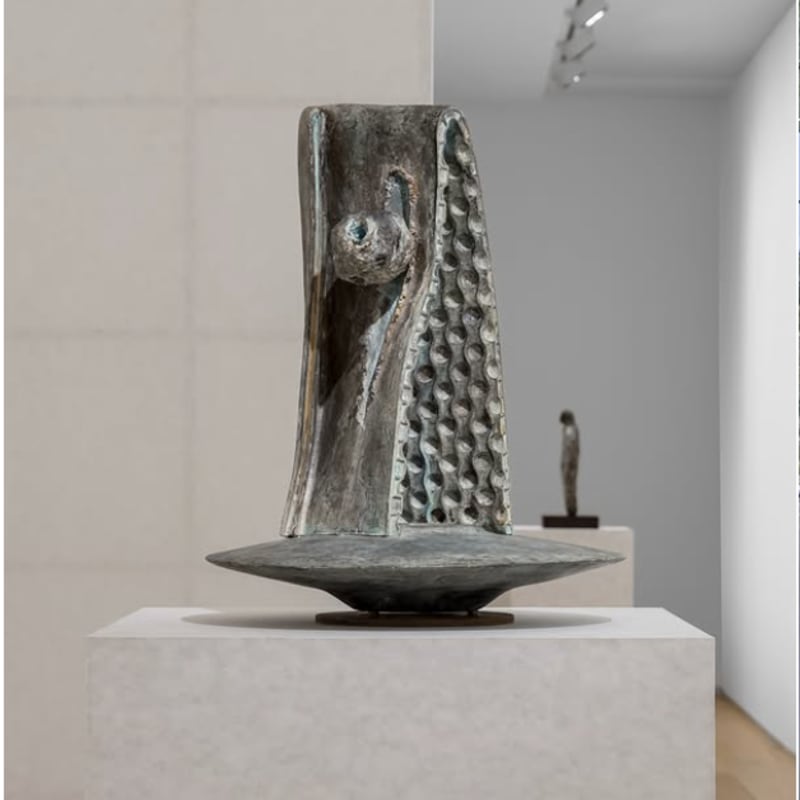The Colourful World of Alvaro Barrington's Tate Commission Gravity and GRACE
Written by Katie Tobin
Alvaro Barrington’s East End studio, housed in the historic site of England’s first free school, is something to behold. Spread across two buildings, the space showcases an unorthodox mix of his preferred mediums and tools: paint, concrete, yarn, hessian, glass, neon lights, milk crates, snare drums, and brooms. In his neo-Jacobean assembly hall, music fills the air; a series of half-finished paintings, characterised by bright block colours and painted on burlap, are on display. It’s an unusual choice of canvas, but Barrington has never been an artist to play it safe.
Born in Venezuela to a Haitian father and a Grenadian mother, he grew up in the Caribbean and Brooklyn before settling in East London. Unlike many working-class immigrants who face hostility, Barrington tells me that he believes in ‘the ability to be seen in a place, and that lets you know you belong there somehow. One of the narratives I have about myself is that I come from a history of working-class immigrants, but I also have the privilege of growing up in a culture of hip-hop and reggae in New York City. That always meant that home became a couple of things to me.’ It’s this idea of home – lost, found, remembered, and reimagined – that remains a core focus of his work; it seems only fitting, then, that Barrington would be drawn to a Whitechapel, a historically immigrant neighbourhood, to set up his multi-purpose art space.
Walking around his studio, it became clear to me that intense commitment to painting means that personal and political questions are inseparable from his work. Barrington’s fusion of different artistic styles and cultural references speaks to an artist grappling with the fundamental issues of identity, memory, and what art can convey. Drawing inspiration from figures as wide-ranging as Cy Twombly, Paul Klee, Louise Bourgeois and Robert Rauschenberg, he creates a vibrant, eclectic mix that reflects his broad interests and playful approach to art history. Silhouetted figures – people dancing, reclining, revelling – are rendered with a playful candour, combining tightly controlled compositions with exuberant candour.
It’s this kind of fervid sensibility that Barrington hopes to bring to his upcoming Tate Britain commission, GRACE, his largest presentation yet, debuting in the museum’s Duveen Galleries. A deeply personal tribute to the women who shaped his life and artistic vision, the installation centres on three key figures: his grandmother Frederica, his close friend Samantha, and his mother Emelda. ‘The first part is about my Grandma,’ he shares with me. ‘We lived in a small shack in Grenada, where the rain hitting the corrugated roof was like a soundtrack. It was always a place of safety and love. I wanted an installation that allowed you to feel the texture of my grandma’s house.’ For GRACE, Barrington recreates this in the South Duveen gallery with a suspended corrugated steel roof, rattan seats, plastic quilts containing embroidered postcards, and the sound of rain mixed with newly commissioned tracks.
Music, a cornerstone of his creative process, energises his work with exultant colour and movement – even after only a quick glance at his vast body of work, it’s hard to deny the totemic influence that artists like Wu Tang Clan and Biggie Smalls have had on Barrington’s practice. ‘I try to capture the essence of music within my painting because it’s a kind of blueprint for me of what makes good art. Tupac is probably the greatest artist in my imagination. They’re North Stars for me,’ he explains. ‘As a painter, Western culture has contributed incredible amounts of innovation to painting, like pointillism and Cubism. But equally, the same could be true for music and black culture – think about jazz, hip-hop, disco, funk. Innovation in Black music has been immense.’ Central to GRACE is Barrington’s considered exploration of care, community, and Black culture – namely those from his childhood in Grenada and Brooklyn with the fervent energy of the carnival culture. The central space features a 3-metre tall aluminium sculpture of a carnival dancer, inspired by and made with Samantha. Adorned with pretty mas jewellery by L’ENCHANTEUR, a costume by Jawara Alleyne, and nails by Mica Hendriks, the figure emboldens that sense of Caribbean vibrancy. Paintings of old mas characters and carnival revellers stretch across scaffold structures, with sunrise and sunset paintings above, redolent of the J’ouvert tradition.


















































































































































































